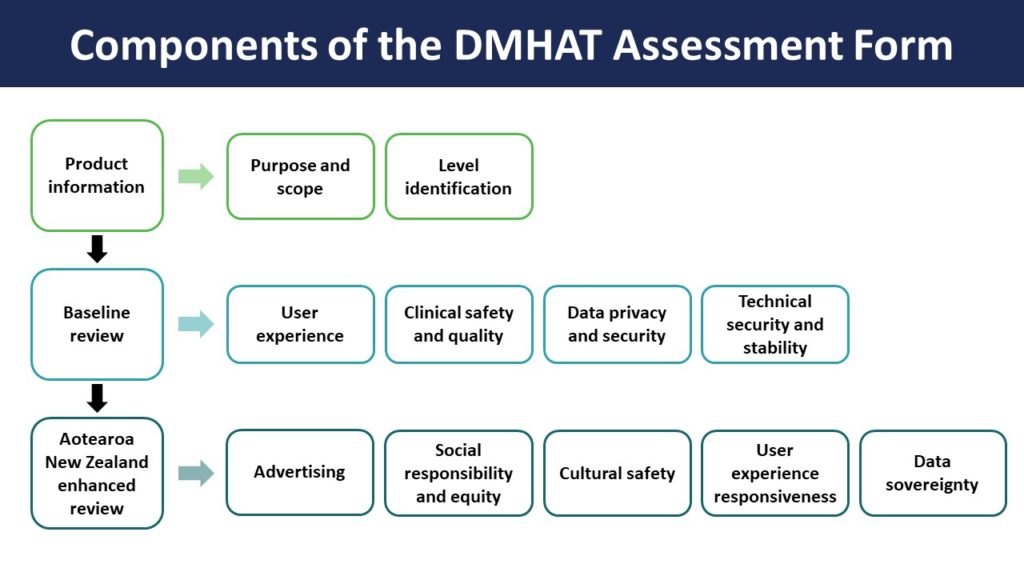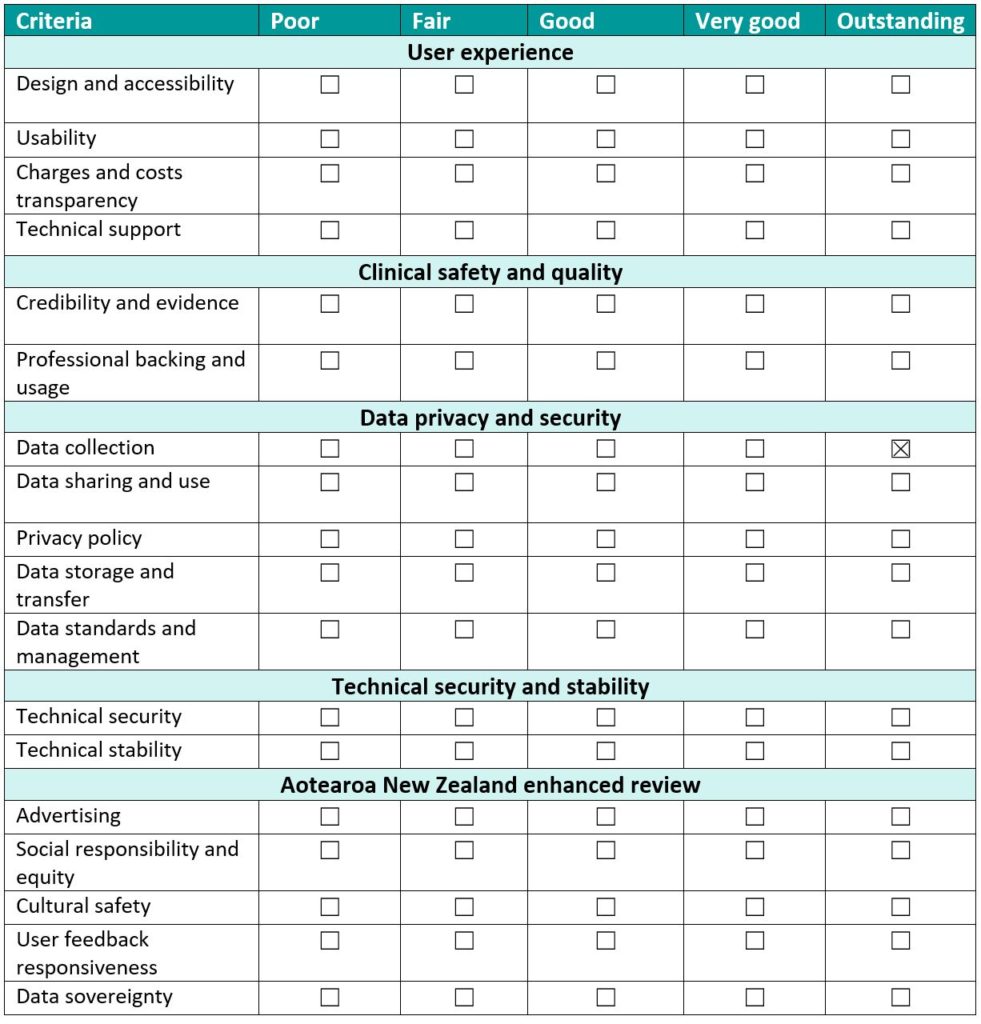Frequently Asked Questions and Answers
DHMAT (Digital Mental Health and Addiction Tool) is an assessment framework for the evaluation of apps and digital tools aimed at supporting mental wellbeing, in Aotearoa New Zealand.
DMHAT was developed in response to the increasing use of digital mental and health tools in Aotearoa New Zealand.
- DHMAT is designed to give all users, including health professionals and consumers, confidence that the digital health tools they use meet international standards of clinical safety, data protection, technical security, interoperability, usability and accessibility standards.
- Uniquely, DMHAT assesses the criteria specific to the use of the app and digital tool within the Aotearoa New Zealand context, by assessing social responsibility and equity, cultural safety including Māori cultural safety, user feedback responsiveness and data sovereignty.
- For developers, DMHAT is intended to support in the design and development of digital tools to deliver robust and appropriate options for our whānau, communities and populations. DMHAT, when fully developed, can also be used by healthcare organisations to assess suppliers at the point of procurement or as part of a due diligence process, to make sure new digital technologies meet minimum baseline standards.
DMHAT starts with a self-assessment process to guide anyone involved in the design and development of digital tools to meet minimum baseline standards, to deliver safe, trusted and effective mental health and wellbeing solutions for whānau (family), communities and populations across Aotearoa New Zealand. The assessment criteria is made up of three core components:
- Product information
- Baseline review and,
- An Aotearoa New Zealand specific enhanced review.
To work through the DMHAT self-assessment process, there are a few documents to guide you:
DMHAT introductory guide
This is an overview document that sets out the standards expected for the development of mental health and wellbeing apps and tools in Aotearoa New Zealand. It includes relevant links to references, standards and rationales for each component of the self-assessment. This is best used early in the development process when exploring standards and baseline requirements.
DMHAT user manual
This document provides detailed question and answer sets and gives comprehensive guidance for completing the self-assessment. It also provides links to supporting resources and indicates the required evidence to make sure your digital tool meets the assessment criteria.
The DMHAT user manual can be used as a standalone document or as a companion document when you are completing the DMHAT self-assessment. The user manual is best used once you are familiar with digital standards and baseline requirements and want more detail on how these standards translate into actionable questions, to make sure your digital tool is assessment ready.
DMHAT self-assessment tool
This is the set of DMHAT questions from the DMHAT user manual, in an online format to make it easier to use. In undertaking a self-assessment, you can choose to use the WORD document or the online version. Note – this information is purely for your own use and will not be used by any external parties to assess your app or digital tool.
A self-assessment approach helps you to determine how well your digital tool meets internationally accepted digital standards and helps you monitor progress towards full concordance. Rather than a punitive, pass/fail approach, the self-assessment approach fosters self-evaluation, along with self-verification and self-enhancement. It is a platform to involve all people concerned in the design and development of the tool and is an impetus for decision-making for ongoing improvement.
Each of the nine sections (four in the baseline review and five in the Aotearoa New Zealand specific enhanced review) comprise reflective questions that help you to focus on the key requirements of each section.
At the end of every section, is a self-assessment rating, allowing you to rate your performance against each of the requirements for that section.
Note:
1] Definition and the description of the five grades are provided within the documents.
2] Scores of each section are assessed individually and are intentionally not combined into a composite score. Presenting these items as a summary score for each section acknowledges that individual measures address quite different issues and aspects of quality. While composite scores may be valid if quality is consistent across different criteria, that is often not the case.
Below is a summary of the overall scoring matrix.
No in its current structure as a self-assessment, DMHAT is not an accreditation tool, although it does have the beginnings of one. Accreditation is a formal, independent verification that a programme or institution meets established quality standards and is competent to carry out specific conformity assessment tasks. Conformity assessment tasks may include, but are not limited to, testing, inspection or certification.
Future implementation plans of DHMAT may evolve into accreditation, but more detail will be required on how to effectively achieve this.
A DMHAT collaborative is in development to help guide the ongoing refinement of the DMHAT criteria and assessment process.
It will provide an online forum and bring together whānau with lived experience, clinicians, health providers, developers, IT experts, researchers, academics and agencies at all levels so that together we can refine the DMHAT assessment framework.
The intention is to champion an open and inclusive approach in the pursuit of exceptional resources for those we love and serve, specifically with New Zealanders in mind.
Consumers and people with lived experience are central to involvement in the DMHAT collaborative. As users of digital tools, consumer, carer and family input is integral to the development and evaluation of apps and digital tools. Taking the diversity of users and their support people into account will achieve the best results.
Out of scope
Given the complexity of artificial intelligence (AI) and cognitive computing technologies, these are both out of scope for assessment in this version of the DMHAT Assessment. Future iterations may be expanded and adjusted to cover these areas in due course.
This Assessment only assesses the digital tool (app or online programme) submitted for appraisal and not any associated devices, add-ons or products supplied, such as dermascopes.
Also out of scope is assessment of service delivery by a third-party organisation using the digital tool or app as part of their programme. There are existing procurement and service delivery assessment frameworks already designed to assess these aspects such as the national Social Services Accreditation Framework.



